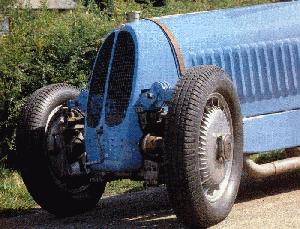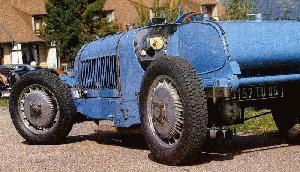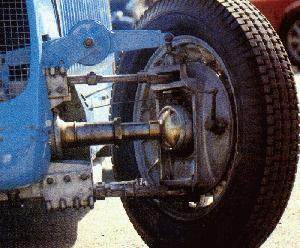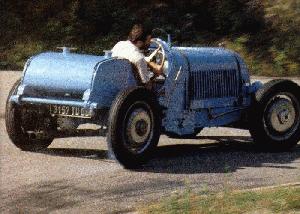

Editor: Jaap Horst

 The mid twenties also had given birth to the first front wheel drive cars, such as the French Tracta designed by engineer Gregoire and the American Miller. Contradictory informations exist about the origin of the Bugatti T53, with two versions of how things went. The historical truth is probably in the sum of a few circumstances which pushed Ettore and his son Jean towards this technical experiment.
The mid twenties also had given birth to the first front wheel drive cars, such as the French Tracta designed by engineer Gregoire and the American Miller. Contradictory informations exist about the origin of the Bugatti T53, with two versions of how things went. The historical truth is probably in the sum of a few circumstances which pushed Ettore and his son Jean towards this technical experiment.
It has been said that after a race at Monza, Bugatti purchased a front wheel drive Miller from the American pilot Duray, giving in exchange one of his Type 35B; the aim was to disassemble the mechanics of the American racing car in order to discover its secrets. This would have triggered the idea of creating a four wheel drive automobile.
It also has been said however, that Bugatti had decided for the integral drive on the basis of a design that an Italian designer, Antonio Pichetto, then in Bugati's staff at Molsheim, had receive from a friend, GC Cappa, a Fiat consultant.
The chronicles of the time tell us that Pichetto had succeeded in convincing Jean Bugatti to such an extent that he then succeeded in convincing his fatather Ettore. It may have helped here that the T50, which raced and failed at Le Mans, was so difficult to handle. Ettore may have thought that four wheel drive would be helpful in using all of the 5 litre blown brute's power.
 A Molsheim's four wheel drive car seemed in fact as the ideal "panacea" to make a comeback in motor racing, as the blue cars were finding it harder to impose themselves. It should be also considered that in those years road races and especially uphill races or hill climbs were extremely popular. Molsheim believed that on rough surfaces and on winding roads a four wheel drive car could have easily defeated its opponents, especially with the 300HP delivered by the Type 50 engine, which were not easily delivered with only rear wheel drive.
A Molsheim's four wheel drive car seemed in fact as the ideal "panacea" to make a comeback in motor racing, as the blue cars were finding it harder to impose themselves. It should be also considered that in those years road races and especially uphill races or hill climbs were extremely popular. Molsheim believed that on rough surfaces and on winding roads a four wheel drive car could have easily defeated its opponents, especially with the 300HP delivered by the Type 50 engine, which were not easily delivered with only rear wheel drive.
The Type 53, the only integral drive Bugatti, made its debut in March 1932, after a two-year gestation. The car's chassis is simple and similar to that of the Type 13 of the twenties, while one feature distinguishes it from most other Bugattis: the radiator grille covers the classic horse-shoe radiator which characterizes almost all of Molsheim's creations, and also protects the mechanical parts of the front wheel drive. The power unit is the 4972 cc eight cylinder of the T50 (not to be confused with the tuned-down T50T mounted in the touring cars) which raced at Le Mans. The car has a four-speed gearbox with an attached central differential (strongly shifted to the left of the car's axis) which transmits powers to the differentials placed on the front and rear axles: a long shaft passes the engine on the left, and also the rear differential is offset in the axle. Power transmission to the wheels on the front axle is by means of universal joints.
Albert Gregoire tried in vain to convince Bugatti not to use these universal joints and to use the homokinetic joints designed by Pierre Fenaille for the Tracta, in fact manufactured by Gregoire himself. In Gregoire's opinion such forecarriage change would have resulted in greater precision for the pilots with no more understeering.
 Bugatti used independent front suspension, with transverse springs and friction shock absorbers. This independent wheel solution was never again used by Bugatti. We conclude this brief technical examination of the Type 53 with mentioning the light alloy wheels, similar to (but not identical) to those of the T50. These are characterized by the special fins, similar to turbine blades, which cool down the brakes, integrated in the wheels. That the car is in fact a prototype can be easily seen from the body, which is in fact not more than a bonnet. The huge tank seems a little overdimensioned if we assume that the car had been designed only for the short hillclimbs.
Bugatti used independent front suspension, with transverse springs and friction shock absorbers. This independent wheel solution was never again used by Bugatti. We conclude this brief technical examination of the Type 53 with mentioning the light alloy wheels, similar to (but not identical) to those of the T50. These are characterized by the special fins, similar to turbine blades, which cool down the brakes, integrated in the wheels. That the car is in fact a prototype can be easily seen from the body, which is in fact not more than a bonnet. The huge tank seems a little overdimensioned if we assume that the car had been designed only for the short hillclimbs.
Apparently only 3 Bugatti Type 53 have been manufactured, of which we are not to sure about the fate of one of them. One is in Mulhouse's Schlumpf collection, where almost the entire Bugatti production is preserved. The second belongs to a private owner and is shown in these pages. Uwe Hucke of Monaco built a replica from factory parts, which he frequently uses.
The car shown here, still perfectly functioning, has been reconstructed on the basis of the car destroyed by Jean Bugatti during the trials of the English Shelsley Walsh race. The chronicles of the time tell us that after the accident Jean Bugatti himself said: "I destroyed it, but at an incredible speed." to stress once again the astonishing speed at which the T53 could take curves, if you were strong enough to control it.
The T53 obtained some important victories; In 1932 Chiron beat the "La Turbie" uphill race record, repeating the feat at Chateau Thierry and at Klausen in the same year. In 1934 Rene Dreyfus improved Louis Chiron's "La Turbie" record with an average speed of over 100 km/h. The short winning cycle of the Bugatti four wheel drive ends in 1935 with Robert Benoist's victory in 1935 at Chateau Thierry.
 The problem's linked to the driving of the car, lay in Ettore Bugatti's stubborness in not wanting to use the homokinetic joints. No attempt was made to use these constant velocity universal joints, and the steering was not only heavy, but reacted to engine torque. The presentation of other, more traditional, models like the T54, on which to concentrate the technical effort, pushed the four wheel drive Type 53 into the attic. It is however sure that the technological research expressed by this model, with the possibilty of disconnecting the integral drive transfoming the car into a front or rear wheel drive car, was taken as an example in the following decades for other four wheel drive experiments, which then led to the reliable FWD models of today.
The problem's linked to the driving of the car, lay in Ettore Bugatti's stubborness in not wanting to use the homokinetic joints. No attempt was made to use these constant velocity universal joints, and the steering was not only heavy, but reacted to engine torque. The presentation of other, more traditional, models like the T54, on which to concentrate the technical effort, pushed the four wheel drive Type 53 into the attic. It is however sure that the technological research expressed by this model, with the possibilty of disconnecting the integral drive transfoming the car into a front or rear wheel drive car, was taken as an example in the following decades for other four wheel drive experiments, which then led to the reliable FWD models of today.
Largely, the T53 is one more of the many "sidesteps" which Ettore and maybe Jean took in trying to increasingly improve the performance of the Molsheim race cars. The T30 "cigar" and the T32 tank are two famous examples of that. The final result of experimenting was magnificent: The T35 and all it's derivatives, until the T51 when the twin cam "Miller head" was introduced, and even the T54 and 59. The T45 sixteen cylinder is another famous example of an "experimental" car, in the continuous search for speed. One of Bugatti's "inventions" however, that has been widely adopted in the racing world was introduced in the T57G "tank" of 1937: Aerodynamics! This was one of the experiments which was more succesfull than the others.